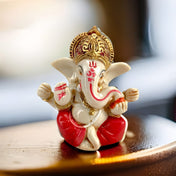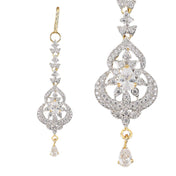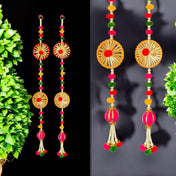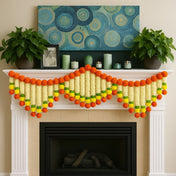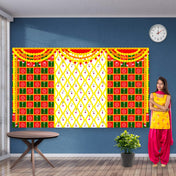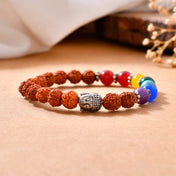The Cultural Significance of Pooja Backdrops is deeply rooted in Indian traditions, where these artistic elements frame sacred rituals and ceremonies. A pooja backdrop serves as more than just a decorative piece; it transforms the ritual space into a sanctified environment that honors the divine presence. Typically crafted with vibrant colors, intricate patterns, and symbolic motifs, the Indian pooja backdrop elevates the spiritual ambiance and invites positive energies.
These backdrops carry centuries-old meanings intertwined with spirituality, mythology, and local customs. They bridge the physical and metaphysical realms, allowing devotees to connect more deeply with their faith during ceremonies. Choosing the right pooja backdrop enriches not only the aesthetics but also the soulfulness of every ritual.
Benefits of Using Pooja Backdrops
Here are some reasons why using pooja backdrops is beneficial:
- Enhances visual appeal of the pooja area
- Reflects cultural heritage and regional artistry
- Creates a focused, serene atmosphere for worship
To create a stunning pooja backdrop for ceremonies, one can follow certain guidelines outlined in this article on how to create a stunning pooja backdrop for ceremonies. These backdrops are not just decorations; they are an essential part of various occasions such as weddings, Diwali, Haldi, housewarming, Annaprassana, Holi and more. A variety of pooja backdrop decoration options are available that cater to these diverse needs.
The Evolution of Pooja Backdrops
The history of pooja backdrops is closely connected to the development of traditional Indian rituals, showcasing both spiritual devotion and artistic expression. In the beginning, these backdrops were simple cloth hangings—often plain or modestly decorated—that created a sacred boundary around the altar or deity. Such simplicity was based on the practical need to define ritual space while keeping it holy.
Over time, pooja backdrops evolved into intricate works of art. Handwoven fabrics, adorned with embroidery, mirrors, and bright dyes, began to represent not just decoration but also respect and good fortune. Temples and royal courts played a role in this transformation by commissioning elaborate tapestries that depicted stories from mythology and scripture.
Regional diversity played a crucial role in shaping styles and materials:
- North India: Rich use of brocade, silk, and zari work with motifs like peacocks and lotuses.
- South India: Traditional cotton backdrops featuring geometric patterns and temple architecture designs.
- East India: Incorporation of kantha embroidery and floral themes from Bengali culture.
- West India: Bandhani-dyed fabrics and mirror work reflecting Rajasthani craftsmanship.
Each region’s natural resources, climate, and cultural influences determined the choice of textiles and artistic motifs. This diverse range of styles continues to inspire modern pooja backdrop designs, paying tribute to heritage while embracing regional uniqueness.
Understanding Traditional Designs
Traditional pooja backdrop designs are intricate tapestries of symbolism and cultural heritage that transform ritual spaces into sanctuaries of devotion. Each motif carries deep spiritual meaning, enhancing the sacred atmosphere essential for worship.
1. Marigold Flowers
Marigolds, with their vibrant orange and yellow hues, are staples in pooja backdrops. They symbolize auspiciousness, purity, and the sun's energy. Their bright colors are believed to attract positive vibrations and ward off negativity, making them indispensable during festivals and religious ceremonies.
2. Lotus Patterns
The lotus flower holds a revered place across Indian spirituality. Its design often adorns pooja backdrops as an emblem of purity, enlightenment, and divine beauty. Emerging pristine from muddy waters, the lotus represents spiritual awakening and transcendence—qualities deeply cherished in ritual contexts.
3. Banana Leaves
Often incorporated into backdrop designs or as physical elements framing the altar, banana leaves signify prosperity, fertility, and good fortune. Their lush green color adds freshness to the setting while embodying nature’s bounty and life’s cyclical renewal.
Each of these motifs contributes layers of meaning that resonate with devotees during worship. The careful arrangement of these symbols within the backdrop creates an environment conducive to meditation, prayer, and connection to the divine.
Traditional pooja backdrop designs serve not only as decorative elements but also as visual prayers—conveying reverence through colors, shapes, and natural elements deeply embedded in Indian culture’s spiritual fabric.
Contemporary Trends in Pooja Backdrops
Contemporary pooja backdrops are an interesting mix of tradition and modernity. Designers are using modern design adaptations that bring new life to ritual spaces while still keeping the cultural significance of pooja backdrops intact. These adaptations include minimalist patterns, eco-friendly materials, and digital printing techniques that allow intricate designs to be reproduced with precision and vibrancy.
Leading the Way in Innovation
Popular brands like LoveNspire are leading the way in this innovation. Their collections combine traditional designs like marigold and lotus with sleek, modern looks—think muted color palettes paired with bold geometric layouts. This approach appeals to younger generations who want to honor their heritage without sacrificing style or convenience.
Key Features of Modern Backdrops
Here are some key features of these modern backdrops:
- Use of sustainable fabrics like organic cotton and bamboo silk.
- Incorporation of LED lighting to highlight sacred symbols during ceremonies.
- Customizable designs allowing personal themes while respecting ritual importance.
- Portable, easy-to-install structures making elaborate setups accessible for urban homes.
Such thoughtful innovations show how pooja backdrops are evolving. They are no longer just decorative elements but also meaningful cultural expressions that gracefully adapt to changing times.
Choosing the Perfect Backdrop for Your Ceremony
Selecting a pooja backdrop involves thoughtful consideration of the type of pooja ceremonies and the ambiance desired. Each ceremony carries its own spiritual energy and cultural significance, which can be beautifully complemented by the right backdrop.
Key factors to consider when selecting a pooja backdrop:
1. Type of Ceremony
Weddings often call for vibrant, elaborate backdrops with auspicious symbols like lotus flowers, peacocks, or traditional embroidery reflecting prosperity and unity. Festivals such as Diwali or Navratri might favor bright marigold garlands or shimmering fabrics that evoke joy and celebration. For such occasions, backdrop cutouts can add a unique touch to your decor. Daily pujas usually require simpler, serene designs focusing on purity—like plain cloths in saffron or white with minimal motifs.
2. Material and Texture
Natural fabrics like silk, cotton, or jute enhance authenticity, while synthetic blends offer durability and ease of maintenance. Consider whether the backdrop will be reused frequently or is for a one-time event.
3. Color Palette
Colors hold symbolic meaning—red for energy and auspiciousness, yellow for sanctity and happiness, green representing growth and harmony. Matching the backdrop color to the deity being worshipped or the mood of the ritual enriches spiritual resonance.
4. Size and Placement
The backdrop should frame the altar neatly without overpowering it. For outdoor ceremonies, weather-resistant materials are ideal. Indoor setups may allow more delicate fabrics enhanced with lighting effects.
5. Customization Options
Personalized backdrops incorporating family crests, deity names, or specific motifs tailored to the occasion add a unique dimension to rituals. If you're looking for some inspiration on how to create a decorative pooja backdrop yourself, there are plenty of DIY tips and ideas available online.
Choosing a pooja backdrop aligned with these considerations elevates the spiritual atmosphere while honoring tradition and personal preferences.
Personalizing Your Pooja Experience with Backdrops
The rise of personalized pooja backdrops reflects a beautiful fusion of tradition and individual expression. Customizing the backdrop allows devotees to create a setting that resonates deeply with their unique spiritual journey and cultural preferences.
Thematic designs have become especially popular, offering a curated visual narrative tailored to specific occasions such as Diwali, Ganesh Chaturthi, or weddings. These themes often incorporate motifs and colors that symbolize the essence of the festival or ritual, enriching the ambiance and elevating the emotional connection.
Consider these elements when choosing or designing a personalized backdrop:
- Color Palette: Selecting hues that align with the deity or festival enhances spiritual energy—reds and golds for auspiciousness, greens for prosperity, blues for calm.
- Motifs & Symbols: Incorporating sacred symbols like Om, Swastika, peacocks, or diyas adds layers of meaning and reverence.
- Material & Texture: Customized fabrics such as silk or brocade with embroidered details lend richness and tactile warmth.
- Personal Touches: Names, family crests, or specific blessings woven into the design make the ritual space intimate and memorable.
Artisans from traditional hubs collaborate with modern designers to craft these bespoke backdrops. Shops like LoveNspire stand out by offering personalized services that honor craftsmanship while meeting contemporary tastes. This approach ensures each pooja backdrop is not just decor but a cherished extension of one’s faith and heritage.
Conclusion
Pooja backdrops are more than just decorations; they play a crucial role in creating a sacred space that promotes respect and mindfulness. When chosen or made with care, these backdrops enhance the spiritual atmosphere, making it easier to connect with the divine.
The importance of pooja backdrops includes:
- Reflecting cultural heritage through traditional designs
- Enhancing the holy ambiance by incorporating symbolic elements
- Personalizing rituals to resonate with individual and community identities
The cultural significance of pooja backdrops is their ability to connect different generations, passing down stories and values found in Indian ceremonies. Each backdrop is not only a visual focal point but also a guardian of tradition, enriching worship by combining art, devotion, and spirituality. Embracing this combination fosters a deep appreciation for heritage, turning every ritual into a vibrant celebration of faith and culture.










